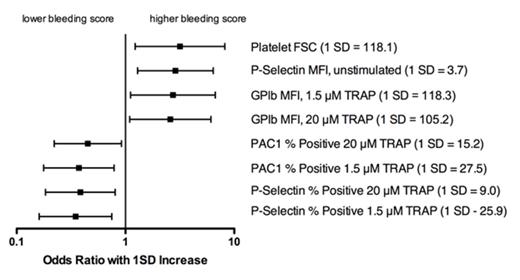Abstract
Immune thrombocytopenia (ITP) patients with similarly low platelet counts differ in their tendency to bleed.
To determine if differences in platelet function in ITP patients with similarly low platelet counts partly account for the variation in bleeding tendency.
The relationship between bleeding scores and platelet function markers was investigated in a single center cross-sectional study of pediatric patients with ITP. Following informed consent, blood was collected from ITP patients and bleeding was graded using the Buchanan and Adix Score (J Pediatr 2002) at routine clinic visits or while admitted to the hospital. Bleeding scores were obtained by one of three hematologists blinded to platelet function results, and investigators performing platelet function tests were blinded to clinical results. Platelet function was assessed by whole blood flow cytometric measurement of unstimulated, ADP- or TRAP-stimulated platelet surface activated GPIIb-IIIa (as measured by PAC1 binding), P-selectin, and GPIb and by unstimulated, convulxin-, or ADP plus TRAP-stimulated platelet surface phosphatidylserine expression (as determined by annexin V binding). Platelet count, immature platelet fraction (IPF) and mean platelet volume (MPV) were determined by a Sysmex XE-2100, and platelet forward angle light scatter (FSC) was measured by flow cytometry.
Platelet function and bleeding scores were evaluated in 34 consecutive consenting pediatric ITP patients (16 female, 18 male, age 9.7 ± 5.7 years [mean ± SD]). ITP was newly diagnosed (< 3 months) in 10 patients, persistent (3 -- 12 months) in 7 patients, and chronic (>12 months) in 17 patients. Platelet count at the time of the blood draw was 47 ± 55 x 109/L. The median bleeding score on day of blood draw was 1 (range 0 to 4). By univariate analysis, higher IPF, and lower platelet count were significantly associated with a higher bleeding score (odds ratio [OR] >1, p<0.05) but MPV was not. Multiple measures of platelet function were associated with bleeding scores by univariate analysis: higher levels of platelet FSC (a measure affected by multiple variables including size) surface GPIb on unstimulated, ADP- or TRAP-stimulated platelets, surface P-selectin on unstimulated platelets, and platelet FSC were associated with increased odds for higher bleeding scores (ORs each >1, p<0.05), while higher ADP- and TRAP-stimulated platelet surface activated GPIIb-IIIa and P-selectin were associated with reduced odds of higher bleeding scores (ORs each <1, p<0.05). After adjustment for platelet count, higher levels of platelet surface P-selectin on unstimulated platelets, GPIb on TRAP-stimulated platelets, and FSC remained significantly associated with increased odds for higher bleeding scores (Figure), but IPF did not. Similarly, after adjustment for platelet count, higher TRAP-stimulated percentage of P-selectin and activated GPIIb-IIIa positive platelets remained significantly associated with reduced odds of higher bleeding scores (Figure). These findings were independent of recent ITP-related treatment.
In this study of pediatric ITP patients, we identified selected platelet function markers which, independent of platelet count, are associated with increased (platelet FSC, platelet surface P-selectin on unstimulated platelets, and GPIb on TRAP-stimulated platelets) or decreased (TRAP-stimulated percent P-selectin and GPIIb-IIIa positive platelets) odds of high bleeding scores. Possible hypotheses to explain these associations are as follows: 1) Increased P-selectin on unstimulated platelets demonstrates in vivo platelet activation, possibly as a consequence of the recent bleeding. 2) Because platelet activation results in a reduction in platelet surface GPIb and increases in platelet surface activated GPIIb-IIIa and P-selectin, the ORs associated with all of these markers could be explained by reduced ability of platelets in patients with higher bleeding scores to respond to agonists. 3) While platelet FSC is partly related to size, the finding that MPV and IPF, adjusted for platelet count, were not associated with bleeding score suggests that factors other than size account for the association of platelet FSC with higher bleeding scores. Further study is required to validate these findings and determine if differences in platelet function are associated with future risk for bleeding.
Off Label Use: Eltrombopag was given to WAS/XLT patients for treatment of thrombocytopenia. Neufeld:Shire: Consultancy, Research Funding; Novartis: Consultancy, Research Funding; Apopharma: Consultancy. Michelson:Sysmex: Honoraria.
Author notes
Asterisk with author names denotes non-ASH members.


